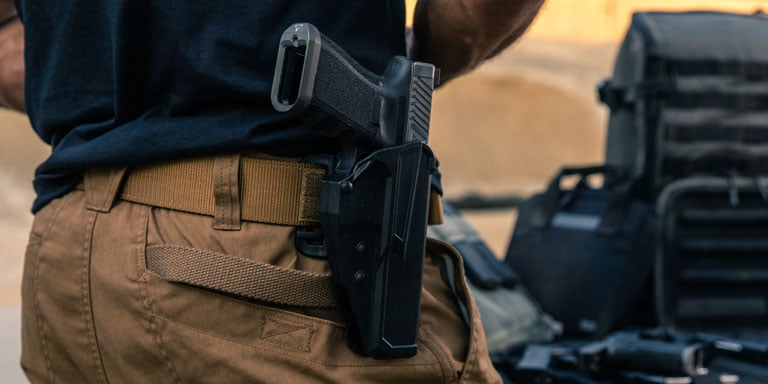How to Choose a Gun Holster
Most of us put a lot of thought into choosing the right handgun because it's an important decision. Unfortunately, many pick up a holster pretty much as an afterthought. It doesn't matter how good your pistol is if you can't rely on it being well protected, easy to handle and quick to get into action. It needs to be the right holster for you, your style of carry and your gun.
Concealed Carry Holsters
Concealed carry holsters don't just have to hold your weapon securely; they need to help make it as inconspicuous as possible. That means bulky flaps, padding and carriage systems are out; low-profile leather is in. There's also a limit to what a holster can do for concealment, and your choice of weapon is going to make a big difference. Opt for a long-barreled, large-frame revolver and your concealed carry options become very limited.
-
Inside The Waistband Holsters
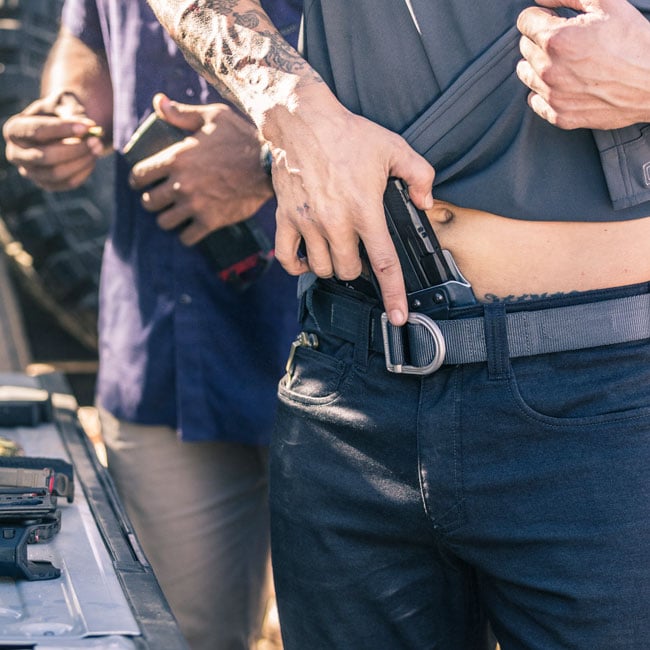
Inside the waistband (IWB) holsters are the most popular option for concealed carry. These holsters secure to your belt with a loop or clip, and hold the pistol inside the waistband of your pants. This is excellent for concealment, as only the butt and rear of the slide are exposed above the waistband. On the other hand it's not the most comfortable style, and exposes the weapon to perspiration. They work best with flatter, compact semiautomatics. Shop IWB Holsters
-
Outside The Waistband Holsters
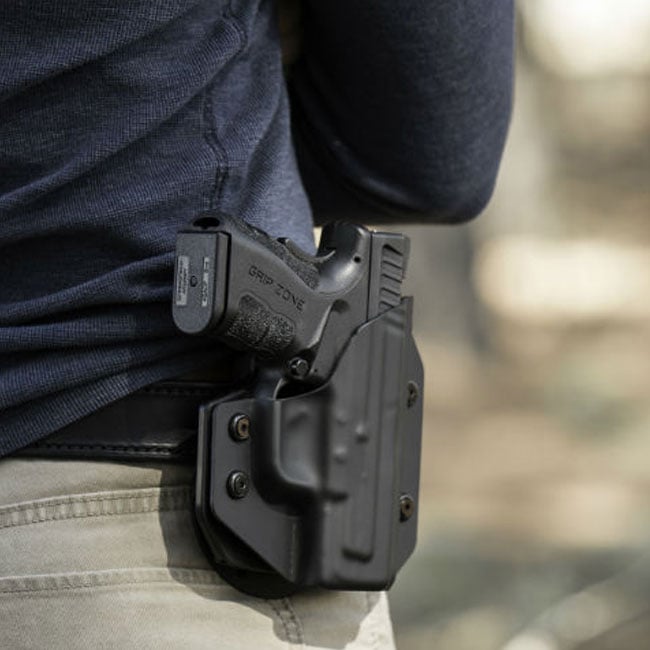
Outside the waistband (OWB) holsters designed for concealed carry are a better option if you're carrying a revolver or larger semiautomatic. These holsters often have wide wings, which both hold it securely on the belt and help smooth out the shape, reducing "printing" on your shirt or coat. Shop OWB Holsters
-
Shoulder Holsters
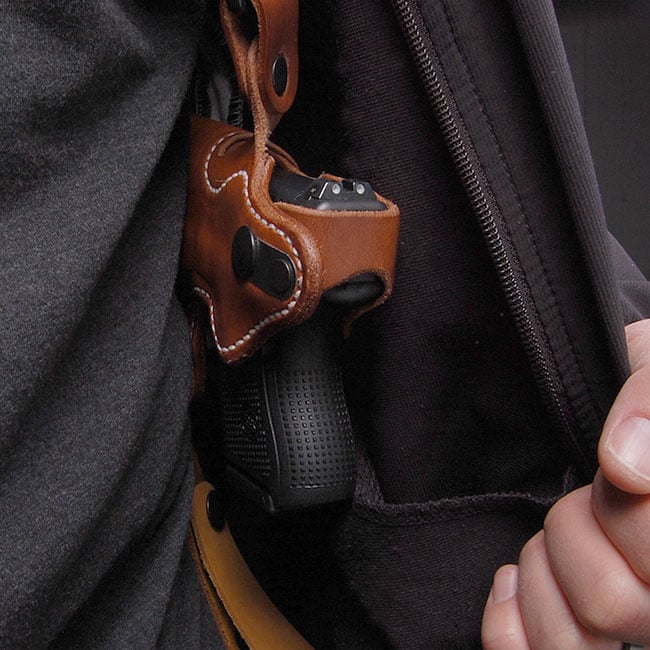
If you spend a lot of time driving or sitting, a waistband holster can be uncomfortable — and drawing can also be awkward. A shoulder holster is a great choice for comfort; the harness has loops over each shoulder, connected by a rear strap, to help spread the weight of the weapon. Shoulder holsters are easily concealed under an open jacket, and allow a fast draw when sitting. Many include a magazine pouch opposite the holster. Another advantage of shoulder holsters is that they're the only really effective way to carry a big revolver concealed. The actual holster can be horizontal for compact handguns, which makes for an easier draw, or vertical for longer-barreled pistols. Shop Shoulder Holsters
-
Pocket Holsters
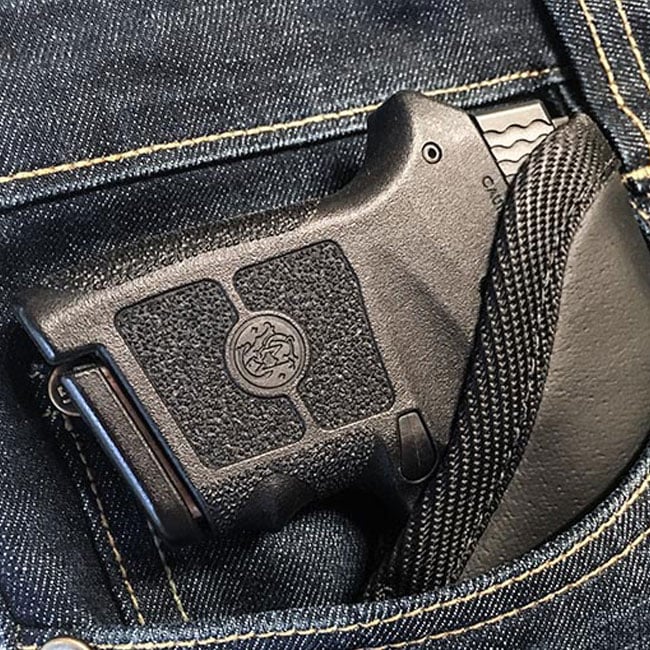
Sometimes it's easiest to just carry a gun in your pocket — but that can lead to snags on your clothing or other pocket contents, slowing your draw or even accidentally letting off a round. A pocket holster protects the gun from snagging and lets you draw cleanly when you need to. Most pocket holsters aren't attached to the inside of the pocket, which makes them quick and easy to move between coats — they rely on friction to hold them in place. You'll often find them with the rough side of the leather outwards, to give more friction against your pocket and less against your gun. Shop Pocket Holsters
-
Ankle Holsters
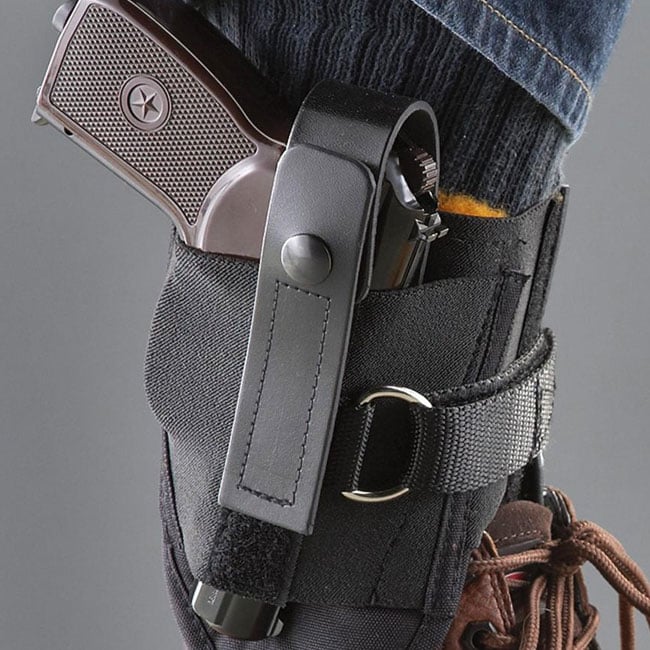
Ankle holsters are usually used for a backup gun — either a subcompact semiautomatic or short-barreled revolver. They do a great job of concealment, and tend to be missed if someone does a hasty or surreptitious pat-down. They do have some issues though. By the time you've bent down and pulled up your pants leg, it's not going to be the fastest draw in history. They can also be uncomfortable if you're doing a lot of physical activity. Running around with a revolver bouncing against your ankle isn't a lot of fun. Shop Ankle Holsters
-
Belly Band Holsters

Designed to hide a handgun under an untucked shirt, a belly band holster is a wide elasticated belt with an integrated holster. They come in several styles that let you choose the exact location of the weapon — anywhere from just above the belt to quite high on the chest. Some are set up to hold the gun at the front of the body and others place it under the armpit. Belly band holsters are good for concealment, but bad for comfort. To hold the weapon firmly in place they need to be tight, and that makes them unpleasant to wear for extended periods. Shop Belly Band Holsters
Open Carry Holsters
-
Belt Holsters
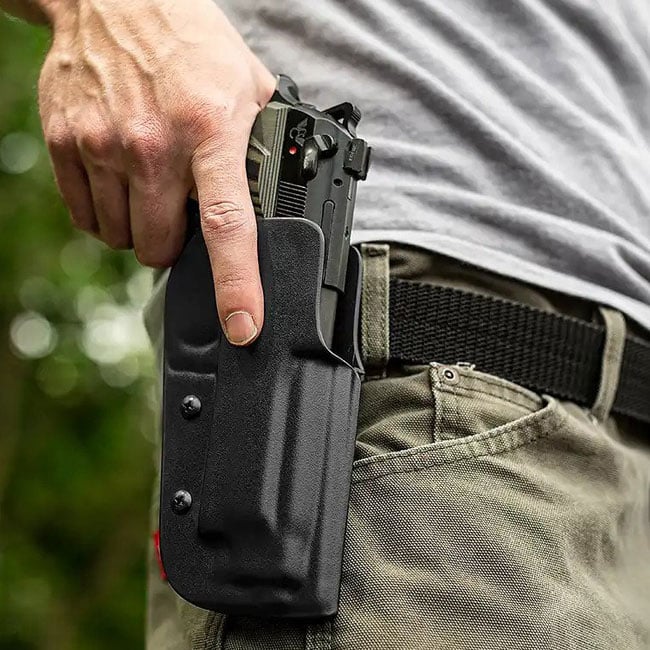
Belt holsters are the most popular choice for open carry, mostly because they're ideal for it. They keep the weapon out of the way but easily accessible. They're secure, staying in position so when you reach for your gun you know exactly where it's going to be. Without the need for concealment a belt holster can have a much more comfortable design, and you also gain more retention options to stop the pistol coming out of the holster until you want it to. If you plan to open carry, an open-topped belt holster with a strap or other retention device is usually going to be the way to go. Shop Belt Holsters
-
Shoulder Holsters
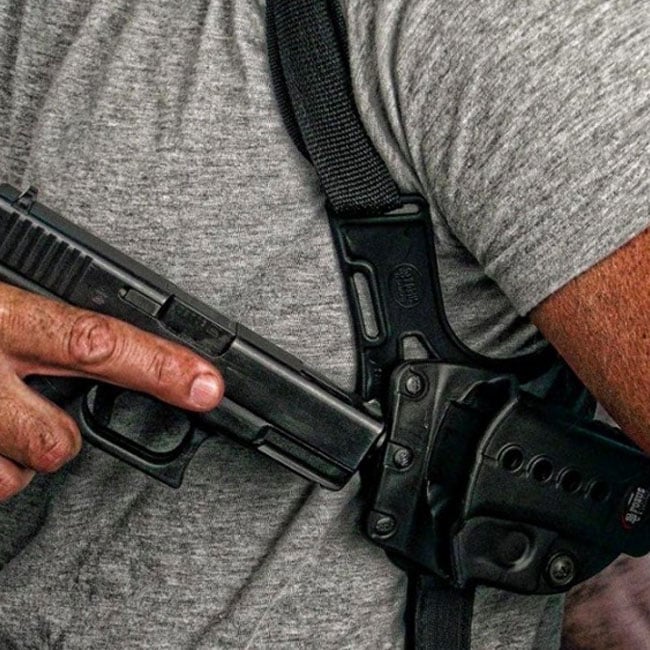
There are times a belt holster isn't ideal for open carry, though. Just the same as for concealed carry, if you spend a lot of time driving or sitting down you'll probably be better off with a shoulder holster. When it comes to shoulder holsters the same holsters tend to be equally suitable for both concealed and open carry. The main difference with open carry is you don't need to worry about wearing a jacket over it. If you're smaller framed you can also get away with carrying a larger handgun — unless you have some bulk for it to disappear against, a 1911 is never going to be all that well concealed. Shop Shoulder Holsters
Duty and Tactical Holsters
Belt Holsters
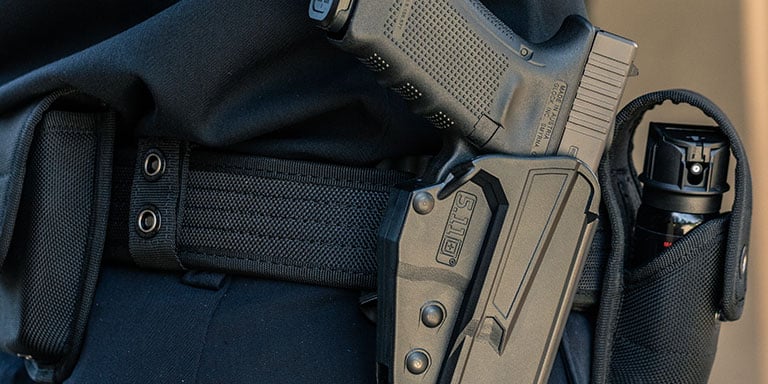
Belt holsters are the traditional military and police solution. An equipment belt or web gear is an ideal support for a holster, and keeps all your equipment together in one unit.
Police belt holsters usually have an open top and some kind of retention. This allows a quick draw, and with modern retention devices there's little chance of anyone else getting hold of the weapon.
Military belt holsters are a little different. For soldiers a quick draw is desirable, but less important than for a cop - few soldiers carry a handgun as their primary weapon, usually senior officers or non-combat specialists. Military handguns live a tough life, though. They're carried for long periods in dirty, muddy, wet, dusty or cold conditions. This means protection is the priority, so most holsters are full-flap designs that cover as much of the gun as possible. Shop Duty Holsters
Drop Leg Holsters
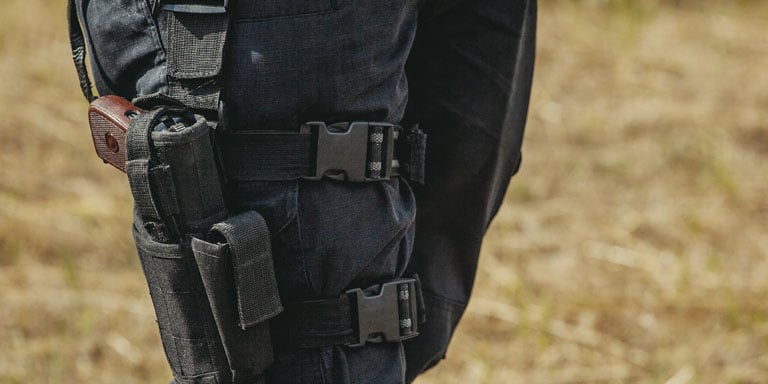
Belt holsters are great, but can be awkward to draw from — especially if you're sitting down. Drop your hand to your side and it's a good 18 inches away from the butt of a pistol holstered on your belt. Practice helps, but a drop leg holster is — in theory, anyway - a more intuitive way of doing it.
Drop leg holsters are suspended from your belt at around mid-thigh, and a strap round the thigh keeps them in place. Extension kits let most military belt holsters be converted to drop-leg. Kits usually contain a thigh panel with a PALS grid and attached retention straps. One big advantage is that they work well with body armor that's long enough to interfere with a belt holster. Learn more about the basics of body armor.
Drop leg holsters are controversial. Some find them easier to draw from, while others say they're more awkward in some positions. Shooters who've trained with belt holsters for years can find it hard to adjust. Drop leg holsters also don't hold the weapon as securely as a belt styles, so they tend to bounce around when you're running. When you're crawling the holster can work its way under your thigh and get dragged through the dirt. Shop Drop Leg Holsters
Shoulder Holsters

A shoulder holster doesn't work well with a full combat load — they become very awkward to draw from when you're reaching around armor loaded down with pouches. For troops who operate in lighter gear, on the other hand, they offer the same advantages as they do for open carry — weight is well distributed and it's easy to draw when sitting down or driving.
One thing to be aware of is that a shoulder holster worn over a uniform is pretty obvious, and thus can be interpreted as aggressive in certain situations. That's not important for everyone, but if you work in CIMIC or HUMINT — where you need to build good relations with local nationals — it can be a problem. Shop Shoulder Holsters
Chest Holsters
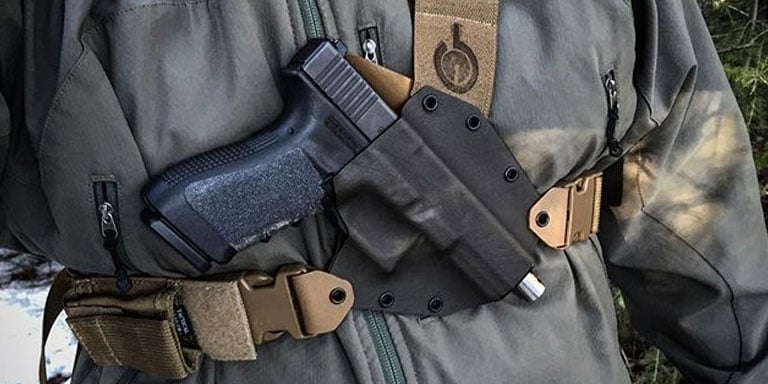
An alternative to shoulder holsters that works well with armor is a chest holster. These usually attach to the PALS grid on any MOLLE-compatible armor (learn more about how to use MOLLE). Positioned so the weapon's butt is over your sternum, they give a fairly easy draw. If you're a driver or vehicle crewman these are a good option. Shop Chest Holsters
Holster Materials
Leather
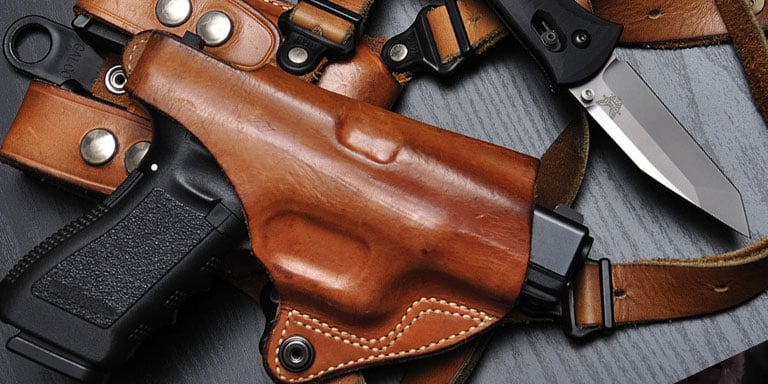
Leather is the traditional holster material, and it's still popular today. Leather is hard wearing, versatile and looks good. Modern leather holsters vary from traditional styles to stiffened, molded ones designed to fit a specific model of pistol.
Leather is a great choice for concealed carry. It's flexible and, with wear, molds to both the body and the weapon. A good leather holster doesn't add much bulk, which helps with concealment.
There are downsides, though. Leather is maintenance-heavy. Poorly maintained leather can collect moisture from rain or sweat, and you really don't want wet leather wrapped round your sidearm all day. It also collects scratches and gouges, which won't damage the holster's function but degrade its looks.
Leather also tends to soften and crease as it ages, and this can be dangerous. Plenty of people have holstered a pistol in old leather which folded, got inside the trigger guard and fired off a round. Shop Leather Holsters
Kydex
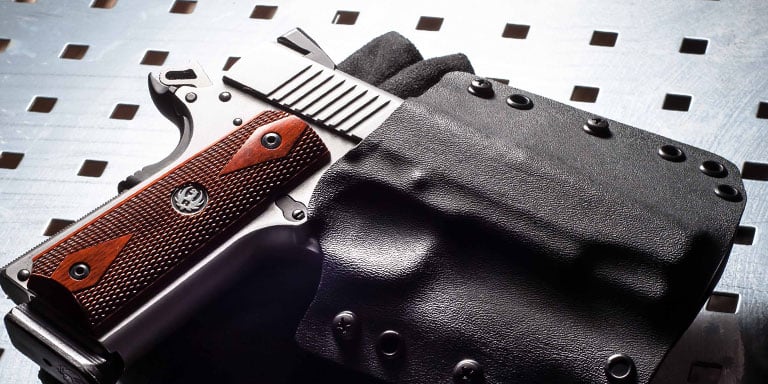
Kydex and other rigid plastics are excellent holster materials. They're tough, can be molded into just about any shape and really protect the weapon. Their rigidity also makes them ideal for holsters with retention systems. Usually they're shaped for a specific weapon.
The main drawback of rigid plastic is that it's often uncomfortable for concealed carry. It doesn't mold to your body the way leather does. Rigid holsters also tend to be bulkier and more obvious.
These materials are low maintenance and don't absorb water, sweat or dirt. Even if they're dripping with mud they can be easily cleaned. Shop Kydex Holsters
Synthetic Fabric
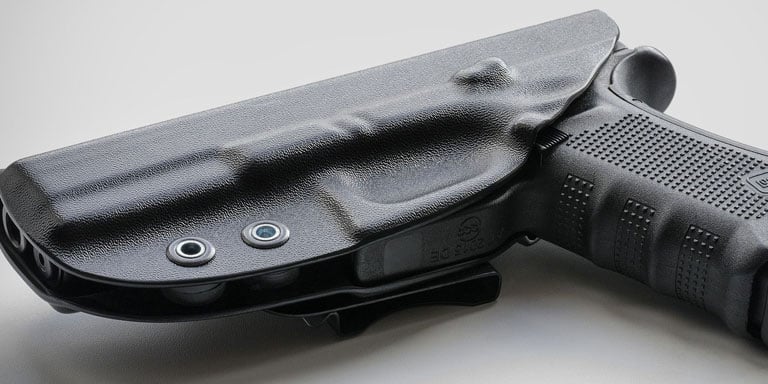
Many synthetic fabrics have been used to make holsters. Synthetic fabrics are (usually) tough and low maintenance. Their other properties put them somewhere between leather and Kydex.
A solidly made nylon holster is pretty bulky, so they're poor for concealed carry. They're also harder to keep clean than Kydex. They're generally more waterproof than leather, though, and protect the weapon well.
These holsters are also more forgiving of slightly different weapons then than they were specifically designed for. That's useful if you don't always carry the same model of pistol. Finally, they can be more comfortable than Kydex because they're less unyielding and offer some padding. Shop Synthetic Fabric Holsters
Retention Methods
So your gun's in the holster. Now you need to make sure it stays there until you want it to come out — but when you do want it in your hand, it needs to be able to get there quickly. There's a variety of retention methods to make that happen.
-
Friction
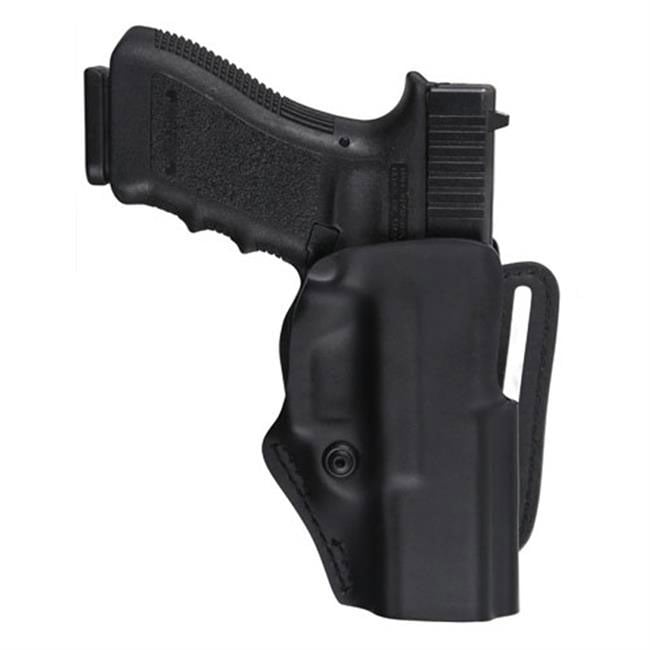
Many holsters don't have any separate retention system; they just rely on friction between the gun and holster to hold it in place. Most concealed carry holsters come into this category. For everyday use it works fine. Nobody should be trying to grab a concealed weapon from you (they won't know you have it, because it's concealed) and you probably won't be running around too much, so a well-made, well maintained holster that fits your gun well should hold it in place just fine. Many modern holsters have a retention screw that can be adjusted to alter the amount of friction — and how securely the gun is held.
-
Flaps

Most traditional military holsters have a flap that covers the butt of the weapon and keeps it secure. These designs are very good at preventing your weapon from falling out, and they also do a great job of protecting it from rain, dust and mud. The downside is that they're slower to use, because you need to open the flap and then get your hand on the gun. Flap holsters are great for use in the field, but a poor choice for everyday civilian carry.
-
Straps
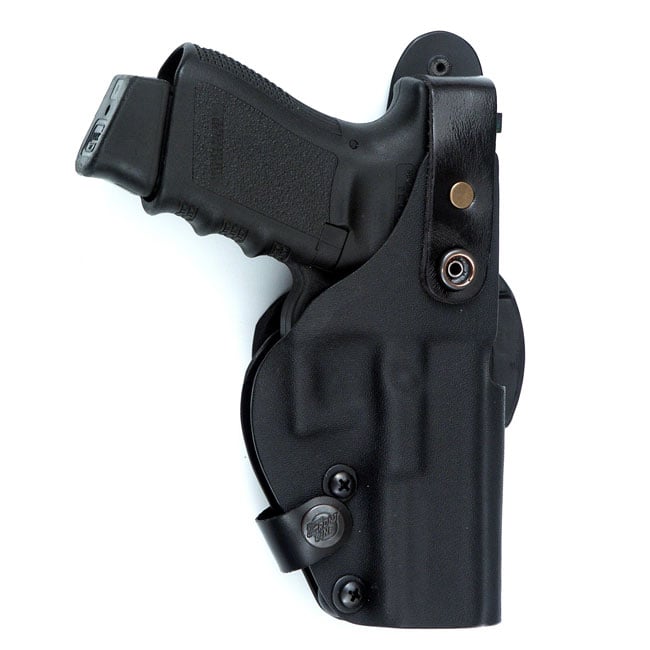
If you don't need to protect your pistol from the elements for weeks at a time, a thumb break strap is a better alternative to a flap. The straps fitted to most traditional police and open carry holsters can be released very quickly. However, while they do protect your gun from falling out, they don't do a lot to stop someone grabbing it — they can release the strap just as easily as you can. Thumb loops — which usually go over the hammer — are similar to straps but don't have a fastener.
-
Trigger Guard Locks

A more modern solution found on many ridgid holsters, especially for police use, trigger guard locks have a hook or post that locks into the weapon's trigger guard. To unlock it you need to operate a button or other device on the outside of the holster. These usually don't take a rocket scientist to work out, but if someone's trying to grab your weapon they won't be able to do it quickly.
Retention Levels
Holsters are typically rated by retention level. A higher level means it's harder for someone to grab your weapon from the holster without your cooperation - but it also usually means your draw will be slower, so more retention isn't always better. The right level for you will depend on why you're carrying. If you're a cop or a civilian who open carries, someone trying to grab your weapon from the holster is a real worry. If you're a soldier, a flap that stops the weapon falling out should usually be fine.
| Description | |
|---|---|
 |
Level 1 relies on friction to hold the weapon in place. A well-fitted Level 1 holster, especially if it has a retention screw, is secure enough to keep your gun in place through most activity - but it does nothing to stop someone else taking it. Most concealed carry holsters are Level 1. Shop Level 1 Holsters. |
 |
Level 2 has a second retention method as well as friction. A strap is the most common option here, but trigger guard locks are gaining popularity. Shop Level 2 holsters. |
 |
Level 3 has two additional retention methods on top of friction. Generally this is a strap and a trigger guard lock. Many police departments specify Level 3 for duty holsters. Shop Level 3 holsters. |
 |
Level 4 has three retention methods, plus friction. Level 4 holsters are extremely secure; it's almost impossible for anyone else to get the gun out if you don't cooperate. |
There's no such thing as the best holster. The one that's best for you depends on a lot of things. Before buying, you need to know exactly what you need it to do. Once you've worked that out you can narrow the field down a lot. It can take a bit of work to make your final choice, but it's worth the effort. Get it right and you'll have a piece of equipment that will protect your weapon and make sure it's where you need it, when you need it. For in-depth firearm knowledge, check out the four rules of gun safety and learn about gun cleaning and maintenance basics.

